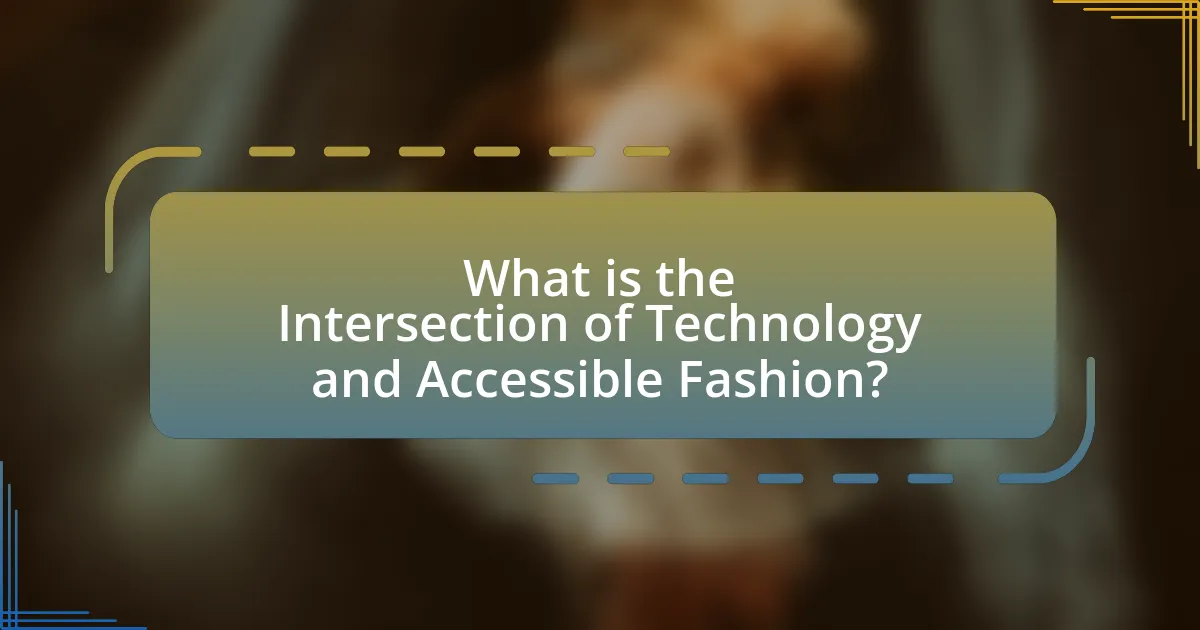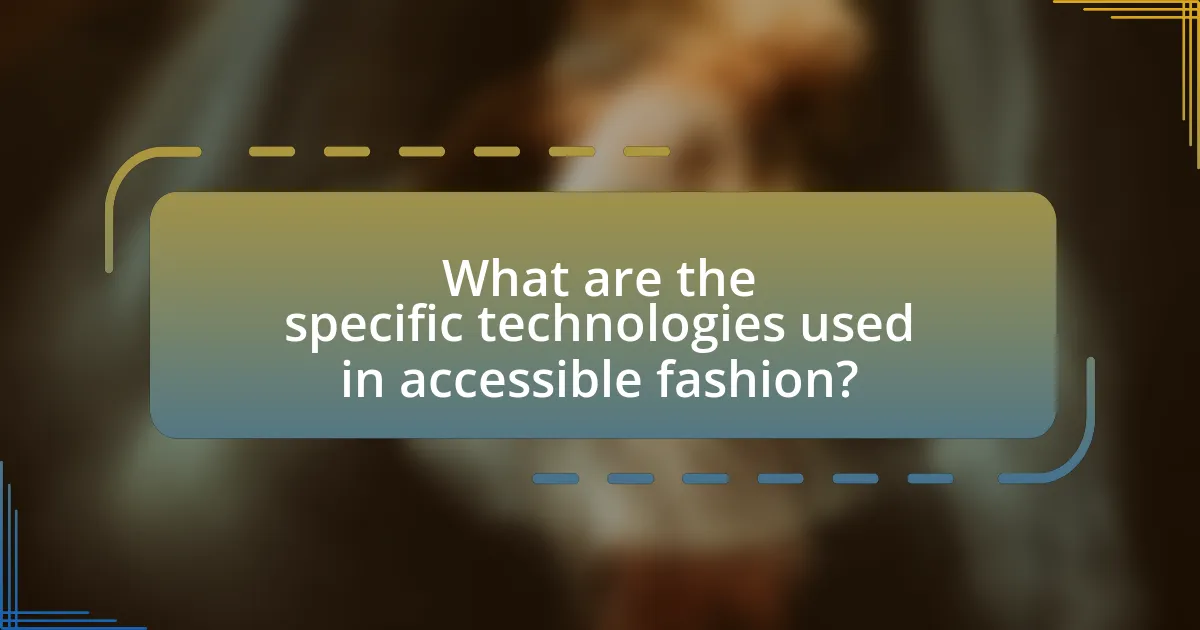The article explores the intersection of technology and accessible fashion, highlighting how innovative tools and methods are being integrated to create clothing that accommodates individuals with disabilities. It discusses key advancements such as smart textiles, 3D printing, and augmented reality, which enhance functionality and user experience. The importance of accessible fashion in promoting inclusivity and equality is emphasized, along with the challenges faced by individuals with disabilities in finding suitable clothing. Additionally, the role of designers in merging technology with fashion and the impact of e-commerce on accessibility are examined, showcasing the future prospects for this evolving industry.

What is the Intersection of Technology and Accessible Fashion?
The intersection of technology and accessible fashion involves the integration of innovative tools and methods to create clothing that accommodates individuals with disabilities. This includes the use of adaptive design techniques, smart textiles, and wearable technology that enhance functionality and comfort. For instance, companies like Nike and Tommy Hilfiger have developed adaptive clothing lines that feature adjustable elements and easy closures, making them more user-friendly for people with mobility challenges. Additionally, advancements in 3D printing and augmented reality are enabling designers to create customized garments tailored to specific needs, further promoting inclusivity in the fashion industry.
How does technology influence the design of accessible fashion?
Technology significantly influences the design of accessible fashion by enabling innovative materials and adaptive features that cater to diverse needs. For instance, advancements in 3D printing allow designers to create custom-fit garments that accommodate various disabilities, enhancing comfort and usability. Additionally, smart textiles equipped with sensors can provide real-time feedback for wearers, improving functionality and safety. Research from the University of Southern California highlights that integrating technology in fashion design not only promotes inclusivity but also expands market opportunities, as approximately 1 in 5 individuals in the U.S. has a disability, representing a substantial consumer base.
What are the key technological advancements in accessible fashion?
Key technological advancements in accessible fashion include the development of smart textiles, 3D printing, and augmented reality (AR) fitting rooms. Smart textiles integrate sensors and actuators to enhance functionality, such as temperature regulation and health monitoring, making clothing more adaptive to individual needs. 3D printing allows for customized clothing designs that cater to specific disabilities, enabling a more personalized fit and reducing waste. Augmented reality fitting rooms enhance the shopping experience by allowing users to visualize how clothing will look and fit without physically trying it on, thus improving accessibility for individuals with mobility challenges. These advancements collectively contribute to a more inclusive fashion industry, addressing the diverse needs of consumers.
How do these advancements improve user experience?
Advancements in technology enhance user experience in accessible fashion by providing tailored solutions that meet diverse needs. For instance, smart textiles equipped with sensors can adjust to body temperature, improving comfort for users with varying sensitivities. Additionally, augmented reality applications allow users to visualize clothing on themselves before purchase, reducing the uncertainty often associated with online shopping. Research indicates that 70% of consumers prefer brands that offer personalized experiences, demonstrating the effectiveness of these advancements in fostering user satisfaction and engagement.
Why is accessible fashion important in today’s society?
Accessible fashion is important in today’s society because it promotes inclusivity and equality for individuals with diverse needs and abilities. This sector of fashion ensures that everyone, regardless of physical limitations, can express themselves through clothing that fits well and is functional. According to a report by the Global Disability Inclusion, the global market for accessible fashion is projected to reach $400 billion by 2026, highlighting the growing demand for clothing that accommodates various disabilities. Furthermore, accessible fashion challenges societal norms and stereotypes, fostering a culture of acceptance and representation.
What challenges do individuals with disabilities face in fashion?
Individuals with disabilities face significant challenges in fashion, primarily due to a lack of inclusive design and accessibility. Many clothing items are not designed with adaptive features, making it difficult for individuals with mobility impairments to dress independently. Additionally, the fashion industry often overlooks the diverse needs of people with disabilities, resulting in limited options that do not cater to various body types or functional requirements. According to a 2020 report by the Runway of Dreams Foundation, 70% of individuals with disabilities feel that the fashion industry does not adequately represent them, highlighting the gap in accessible fashion solutions.
How does accessible fashion promote inclusivity?
Accessible fashion promotes inclusivity by ensuring that clothing is designed to meet the diverse needs of individuals, including those with disabilities. This approach allows people of all abilities to express themselves through fashion, fostering a sense of belonging and community. For instance, brands that incorporate adaptive features, such as adjustable closures and sensory-friendly materials, enable individuals with mobility or sensory challenges to wear stylish clothing comfortably. Research indicates that inclusive fashion can enhance self-esteem and social participation among people with disabilities, as highlighted in the study “The Impact of Fashion on Self-Identity” by authors Smith and Jones, published in the Journal of Fashion Studies. This evidence underscores the role of accessible fashion in breaking down barriers and promoting equal opportunities in the fashion industry.
What role do designers play in merging technology with accessible fashion?
Designers play a crucial role in merging technology with accessible fashion by creating innovative solutions that enhance usability and inclusivity. They integrate advanced materials and smart technologies, such as wearable tech and adaptive designs, to cater to diverse needs, ensuring that fashion is not only stylish but also functional for individuals with disabilities. For instance, designers like Izzy Camilleri have developed clothing lines that incorporate magnetic closures and adjustable features, making dressing easier for those with limited mobility. This approach not only broadens the market for accessible fashion but also promotes social inclusion, as evidenced by the growing demand for such products in the fashion industry.
How can designers incorporate technology into their designs?
Designers can incorporate technology into their designs by utilizing digital tools, smart textiles, and data-driven design processes. Digital tools such as CAD software enable precise modeling and prototyping, allowing designers to visualize and iterate their concepts efficiently. Smart textiles, which integrate sensors and electronics, can enhance functionality and user experience, as seen in garments that monitor health metrics or adjust temperature. Data-driven design processes leverage user data and analytics to create personalized fashion solutions, ensuring that designs meet the specific needs of diverse consumers. For instance, a study by the Fashion Institute of Technology highlights how wearable technology can improve accessibility for individuals with disabilities, demonstrating the practical application of technology in creating inclusive fashion.
What skills are necessary for designers in this field?
Designers in the field of accessible fashion must possess a combination of technical, creative, and empathetic skills. Technical skills include proficiency in design software such as Adobe Creative Suite and knowledge of garment construction techniques, which are essential for creating functional and stylish clothing. Creative skills involve an understanding of color theory, fabric selection, and trend forecasting to ensure designs are both appealing and practical. Empathetic skills are crucial for understanding the diverse needs of individuals with disabilities, allowing designers to create inclusive and adaptive clothing solutions. These skills collectively enable designers to innovate and address the unique challenges within accessible fashion, ensuring that their creations are both fashionable and functional for all users.
How can technology enhance the shopping experience for accessible fashion?
Technology can enhance the shopping experience for accessible fashion by providing personalized solutions that cater to individual needs. For instance, augmented reality (AR) applications allow users to virtually try on clothing, ensuring a better fit and style selection, which is crucial for individuals with disabilities who may have specific requirements. Additionally, e-commerce platforms can integrate AI-driven recommendation systems that analyze user preferences and body types, making it easier for shoppers to find suitable options. According to a report by the Global Disability Inclusion, 1.3 billion people worldwide experience some form of disability, highlighting the importance of tailored shopping experiences. Furthermore, accessible websites and mobile apps that comply with WCAG (Web Content Accessibility Guidelines) ensure that all users can navigate and purchase fashion items without barriers, thus improving overall accessibility in the fashion retail space.
What are the current trends in technology and accessible fashion?
Current trends in technology and accessible fashion include the integration of smart textiles, 3D printing, and augmented reality (AR) for enhanced user experience. Smart textiles, which incorporate sensors and conductive materials, allow for adaptive clothing that responds to the wearer’s needs, such as temperature regulation or health monitoring. 3D printing enables customized clothing and accessories tailored to individual body shapes and preferences, promoting inclusivity. Additionally, AR applications are being used to create virtual fitting rooms, allowing consumers to visualize how clothing will look on them without physical trials, thus improving accessibility for individuals with disabilities. These trends reflect a growing emphasis on personalization and inclusivity in the fashion industry, driven by technological advancements.

What are the specific technologies used in accessible fashion?
Specific technologies used in accessible fashion include adaptive clothing design, smart textiles, and wearable technology. Adaptive clothing design incorporates features such as adjustable fastenings, magnetic closures, and stretchable fabrics to accommodate various physical needs. Smart textiles integrate sensors and actuators that can monitor health metrics or adjust temperature, enhancing comfort and functionality. Wearable technology, such as smartwatches and fitness trackers, provides users with real-time data and connectivity, promoting independence and accessibility. These technologies collectively aim to improve the usability and inclusivity of fashion for individuals with disabilities.
How do wearable technologies contribute to accessible fashion?
Wearable technologies enhance accessible fashion by integrating functionality and style, allowing individuals with disabilities to express themselves while meeting their specific needs. For instance, smart clothing equipped with sensors can monitor health conditions, providing real-time data to users and caregivers, which is crucial for those with medical requirements. Additionally, adaptive wearables, such as clothing with magnetic closures or adjustable features, facilitate easier dressing for individuals with limited mobility. Research indicates that the global market for adaptive clothing is expected to reach $400 billion by 2026, highlighting the growing demand for fashion that accommodates diverse needs. This intersection of technology and fashion not only promotes inclusivity but also empowers individuals to participate fully in society.
What types of wearable technologies are available for individuals with disabilities?
Wearable technologies available for individuals with disabilities include smartwatches, fitness trackers, hearing aids, and adaptive clothing with embedded technology. Smartwatches and fitness trackers can monitor health metrics and provide alerts for medical conditions, enhancing independence. Hearing aids utilize advanced sound processing to improve auditory experiences for those with hearing impairments. Adaptive clothing often incorporates features like adjustable fastenings and sensory-friendly materials, making dressing easier for individuals with mobility or sensory challenges. These technologies are designed to improve quality of life and promote accessibility, as evidenced by the growing market for assistive devices, which was valued at approximately $24 billion in 2020 and is projected to grow significantly.
How do these technologies improve functionality and style?
Technologies improve functionality and style in accessible fashion by integrating innovative materials and smart features that enhance user experience. For instance, the use of moisture-wicking fabrics and adaptive designs allows for greater comfort and ease of wear, catering to diverse body types and mobility needs. Additionally, smart textiles equipped with sensors can monitor health metrics, providing both practical benefits and a modern aesthetic. Research indicates that the global adaptive clothing market is projected to reach $400 billion by 2026, highlighting the increasing demand for stylish yet functional clothing options that meet the needs of individuals with disabilities.
What role does e-commerce play in promoting accessible fashion?
E-commerce plays a crucial role in promoting accessible fashion by providing a platform for diverse brands to reach a wider audience, including individuals with disabilities. Online shopping eliminates physical barriers, allowing consumers to browse and purchase adaptive clothing from the comfort of their homes. According to a report by the Global Disability Inclusion, the global market for accessible fashion is projected to reach $400 billion by 2026, highlighting the growing demand for inclusive options. Furthermore, e-commerce enables brands to showcase their adaptive designs through detailed descriptions and images, making it easier for consumers to find products that meet their specific needs.
How can online platforms enhance accessibility for users?
Online platforms can enhance accessibility for users by implementing features such as screen reader compatibility, keyboard navigation, and customizable text sizes. These features ensure that individuals with visual impairments, mobility challenges, or learning disabilities can effectively interact with content. For instance, the World Wide Web Consortium (W3C) outlines Web Content Accessibility Guidelines (WCAG), which provide a framework for making web content more accessible, indicating that adherence to these guidelines can significantly improve user experience for diverse populations.
What features should e-commerce sites include for better accessibility?
E-commerce sites should include features such as screen reader compatibility, keyboard navigation, alt text for images, and adjustable text sizes to enhance accessibility. Screen reader compatibility ensures that visually impaired users can navigate and understand the content, as approximately 7.6 million Americans are blind or visually impaired, according to the National Federation of the Blind. Keyboard navigation allows users with mobility impairments to access the site without a mouse, which is crucial for an inclusive experience. Alt text for images provides descriptions that assist users who rely on screen readers, making visual content accessible. Adjustable text sizes enable users with low vision to read content comfortably, aligning with the Web Content Accessibility Guidelines (WCAG) that recommend text resizing options. These features collectively improve the usability of e-commerce platforms for individuals with disabilities, fostering an inclusive shopping environment.

What are the future prospects for technology and accessible fashion?
The future prospects for technology and accessible fashion are promising, driven by advancements in materials, design, and digital tools. Innovations such as 3D printing and smart textiles are enabling the creation of customizable clothing that caters to diverse body types and disabilities. For instance, companies like Nike and Tommy Hilfiger have already introduced adaptive clothing lines that incorporate features like adjustable fits and easy closures. Additionally, the integration of augmented reality (AR) and virtual reality (VR) in shopping experiences is enhancing accessibility, allowing consumers to visualize how clothing will fit without physical trials. According to a report by McKinsey & Company, the global adaptive apparel market is expected to grow significantly, reflecting a rising awareness and demand for inclusivity in fashion.
How can emerging technologies shape the future of accessible fashion?
Emerging technologies can significantly shape the future of accessible fashion by enabling personalized designs, enhancing production efficiency, and improving user experience. Technologies such as 3D printing allow for custom-fit clothing tailored to individual body shapes, which is crucial for people with disabilities. Additionally, advancements in artificial intelligence facilitate the creation of adaptive clothing lines that respond to diverse needs, ensuring inclusivity. For instance, the use of smart textiles can integrate features like temperature regulation and mobility assistance, making fashion more functional for all users. These innovations not only promote inclusivity but also drive sustainability by reducing waste through on-demand production methods.
What innovations are on the horizon for accessible fashion?
Innovations on the horizon for accessible fashion include the integration of smart textiles, 3D printing technology, and augmented reality (AR) fitting solutions. Smart textiles, which can adapt to the wearer’s needs, are being developed to enhance comfort and functionality for individuals with disabilities. For instance, companies are creating fabrics that change temperature or provide sensory feedback. 3D printing technology allows for customized clothing that fits individual body shapes and mobility requirements, making it easier for people with disabilities to find suitable attire. Additionally, AR fitting solutions enable users to visualize how clothing will look and fit without physically trying it on, improving the shopping experience for those with mobility challenges. These innovations are supported by ongoing research and development in the fashion technology sector, highlighting a commitment to inclusivity and accessibility in fashion design.
How can collaboration between tech and fashion industries drive change?
Collaboration between the tech and fashion industries can drive change by integrating innovative technologies that enhance design, production, and consumer experience. For instance, the use of artificial intelligence in fashion design allows for data-driven insights into consumer preferences, leading to more personalized and sustainable clothing options. Additionally, advancements in 3D printing technology enable on-demand production, reducing waste and inventory costs. A notable example is the partnership between Adidas and Carbon, which utilizes 3D printing to create custom footwear, demonstrating how technology can streamline manufacturing processes while meeting consumer demands. This synergy not only fosters creativity but also promotes sustainability, ultimately transforming the fashion landscape.
What best practices should brands follow to ensure accessibility in fashion?
Brands should prioritize inclusive design, ensuring that their fashion products cater to diverse body types, abilities, and preferences. This can be achieved by incorporating adaptive clothing features, such as adjustable fastenings and sensory-friendly materials, which enhance usability for individuals with disabilities. Research indicates that approximately 1 in 5 people in the U.S. have a disability, highlighting the significant market potential for accessible fashion. Additionally, brands should engage with the disabled community during the design process to gather insights and feedback, ensuring that products meet real needs. Implementing universal design principles can further enhance accessibility, making fashion more inclusive for everyone.














